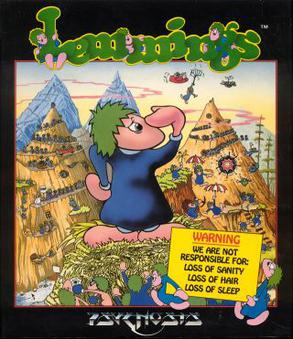
Lemmings is a puzzle-strategy video game originally developed by DMA Design and published by Psygnosis for the Amiga in 1991 and later ported for numerous other platforms. The game was programmed by Russell Kay, Mike Dailly and David Jones, and was inspired by a simple animation that Dailly created while experimenting with Deluxe Paint.

Indiana Jones and the Fate of Atlantis is a point-and-click adventure game developed and published by LucasArts and released in June 1992 for Amiga, DOS, and Macintosh. Almost a year later, it was reissued on CD-ROM as an enhanced "talkie" edition with full voice acting and digitized sound effects. The seventh game to use the script language SCUMM, Fate of Atlantis has the player explore environments and interact with objects and characters by using commands constructed with predetermined verbs. It features three unique paths to select, influencing story development, gameplay and puzzles. The game used an updated SCUMM engine and required a 286-based PC, although it still runs as a real-mode DOS application. The CD talkie version required EMS memory enabled to load the voice data.
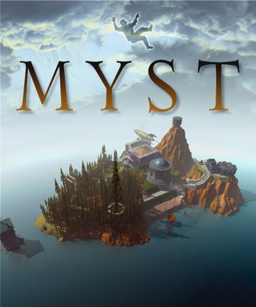
Myst is an adventure video game designed by Rand and Robyn Miller. It was developed by Cyan, Inc., published by Broderbund, and first released in 1993 for the Macintosh. In the game, the player travels via a special book to a mysterious island called Myst. The player interacts with objects and traverses the environment by clicking on pre-rendered imagery. Solving puzzles allows the player to travel to other worlds ("Ages"), which reveal the backstory of the game's characters and help the player make the choice of whom to aid.

Return to Zork is a 1993 graphic adventure game in the Zork series. It was developed by Activision and was the final Zork game to be published under the Infocom label.
Jonny Quest is a science fiction–adventure media franchise created by Doug Wildey for Hanna-Barbera. It revolves around the titular Jonny Quest, a boy who accompanies his scientist father on extraordinary adventures. The franchise started with a 1964–65 television series of the same name, and has come to include two sequel television series, two television films and three video games. It is currently owned by Warner Bros. after Hanna-Barbera was absorbed by Warner Bros. Animation and succeeded by Cartoon Network Studios.

The 7th Guest is an interactive movie puzzle adventure game, produced by Trilobyte and originally released by Virgin Interactive Entertainment in April 1993. It is one of the first computer video games to be released only on CD-ROM. The 7th Guest is a horror story told from the unfolding perspective of the player, as an amnesiac. The game received press attention for making live action video clips a core part of its gameplay, for its then-unprecedented amount of pre-rendered 3D graphics, and for its adult content. The game was very successful, with over two million copies sold. The game alongside Myst, is widely regarded as a killer app that accelerated the sales of CD-ROM drives. The 7th Guest has subsequently been re-released on Apple's app store for various systems such as the Mac. Bill Gates called The 7th Guest "the new standard in interactive entertainment".
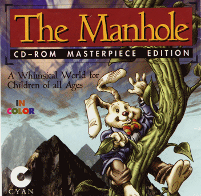
The Manhole is an adventure video game in which the player opens a manhole and reveals a gigantic beanstalk, leading to fantastic worlds.

The Daedalus Encounter is a 1995 interactive movie puzzle adventure game developed by Mechadeus and published by Virgin Interactive for Windows. The game was ported to the 3DO by Lifelike Productions and published by Panasonic. The premise of the game is that there are three space marines who have fought as part of an interstellar war. One of them, Casey, has been brought back to life by his partners after a space accident and he is now a brain grafted in a life-support system. In order to save themselves, the three characters and the player solve all sorts of puzzles.

King's Quest V: Absence Makes the Heart Go Yonder! is a 1990 graphic adventure game by Sierra On-Line. Originally released in November 1990, it featured a significant improvement in graphics. It was also the first King's Quest installment to replace the typing user interface with a point-and-click user interface. The title is a spoof on the proverb "Absence makes the heart grow fonder".

King's Quest VI: Heir Today, Gone Tomorrow is a point-and-click adventure game, first released in 1992 as the sixth installment in the King's Quest series produced by Sierra On-Line. Written by Roberta Williams and Jane Jensen, King's Quest VI is widely recognized as the high point in the series for its landmark 3D graphic introduction movie and professional voice acting. King's Quest VI was programmed in Sierra's Creative Interpreter and was the last King's Quest game to be released on floppy disk. A CD-ROM version of the game was released in 1993, including more character voices, a slightly different opening movie and more detailed artwork and animation.

The Real Adventures of Jonny Quest is an American animated television series produced by Hanna-Barbera and broadcast on Cartoon Network from August 26, 1996, to April 16, 1997. It is a continuation of Jonny Quest (1964) and The New Adventures of Jonny Quest (1986) and features teenage adventurers Jonny Quest, Hadji Singh, and Jessie Bannon as they accompany Dr. Benton Quest and bodyguard Race Bannon to investigate strange phenomena, legends, and mysteries in exotic locales. Action also takes place in the virtual realm of QuestWorld, a three-dimensional cyberspace domain rendered with computer animation. Conceived in the early 1990s, Real Adventures suffered a long and troubled development.

Toonstruck is a graphic adventure video game developed by Burst Studios, published by Virgin Interactive Entertainment and released in 1996 for DOS. The game features hand-drawn imagery and animated characters, but the protagonist Drew Blanc is represented as a video-captured live action character interacting with the cartoon world around him. In the game, Blanc is transported into the cartoon world he created while suffering from a creative block. Blanc is accompanied by his animated sidekick Flux Wildly.

The Pandora Directive is the fourth installment in the Tex Murphy series of graphic adventure games produced by Access Software. After its creators reacquired the rights to the series, it was re-released on Good Old Games in July 2009.

Leisure Suit Larry 6: Shape Up or Slip Out! is the fifth entry in the Leisure Suit Larry series of graphical adventure games published by Sierra On-Line and is a sequel to the 1991 video game, Leisure Suit Larry 5: Passionate Patti Does a Little Undercover Work. Originally developed for MS-DOS in 1993, an enhanced CD-ROM version was published a year later.

Space Quest IV: Roger Wilco and the Time Rippers is a 1991 graphic adventure game by Sierra On-Line, and the fourth entry in the Space Quest series. The game was released originally on floppy disks in March 1991, and later released on CD-ROM in December 1992 with full speech support; an Atari ST version was announced via Sierra Online's magazine, Sierra News Magazine, but was later canceled. The game sees players assume the role of Roger Wilco, who is thrust into a new adventure across time and space where he must thwart the plans of an old foe that is seeking revenge against him.
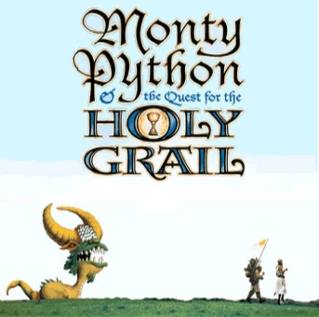
Monty Python & the Quest for the Holy Grail is an adventure game created by 7th Level in 1996 for Windows. The game is based on the 1975 film Monty Python and the Holy Grail and was the second of three Monty Python games created by 7th Level.
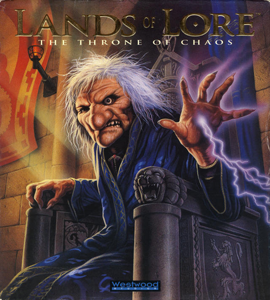
Lands of Lore: The Throne of Chaos is a 1993 role-playing video game developed by Westwood Studios and published by Virgin Games for MS-DOS, the NEC PC-9801, and FM Towns. It was the first installment of the Lands of Lore series. The player travels around various environments, collecting items and battling monsters in an attempt to save the kingdom from a witch named Scotia, who has acquired shape-shifting abilities.

Disney's Animated Storybook is a point-and-click adventure interactive storybook video game series based on Walt Disney feature animations and Pixar films that were released throughout the 1990s. They were published by Disney Interactive for personal computers for children ages four to eight years old. Starting from 1994, most of the entries in the series were developed by Media Station. They have the same plots as their respective films, though abridged due to the limited medium.

Jewels of the Oracle is a 1995 adventure game developed by ELOI Productions and published by Discis Knowledge Research Inc. It was released on Macintosh, PlayStation, Sega Saturn, and Windows. A sequel developed by Bardworks and published by Hoffman and Associates was released in 1998 entitled Jewels II: The Ultimate Challenge.
Madeline is a series of educational point-and-click adventure video games which were developed during the mid-1990s for Windows and Mac systems. The games are an extension of the Madeline series of children's books by Ludwig Bemelmans, which describe the adventures of a young French girl. The video-game series was produced concurrently with a TV series of the same name, with characters and voice actors from the show.

















